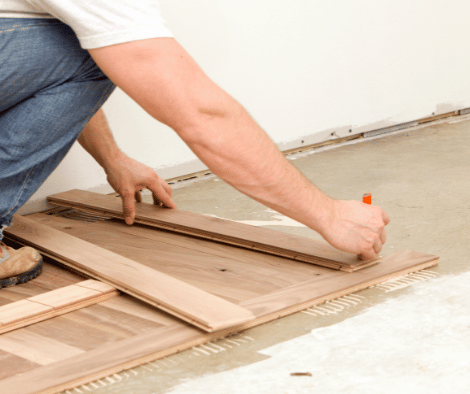Do You Need A Permit For Hardwood Floor Installation?

Do I Need a Permit for Hardwood Floor Refinishing?
At Choice Hardwoods, we often get asked by our clients whether a permit is required for hardwood floor refinishing projects. It’s a reasonable question, as many homeowners are unsure about the rules and regulations surrounding home improvement projects. The good news is that for most hardwood floor refinishing projects, no permit is required. However, there are certain situations where a permit might be necessary, and it’s important to understand the conditions that could trigger the need for one.
In this article, we’ll take a closer look at when you might need a permit for refinishing hardwood floors, and clarify why, in most cases, you can proceed with refinishing without worrying about permits or local regulations.
Refinishing Hardwood Floors – No Permit Needed
For most standard hardwood floor refinishing jobs, such as sanding, staining, and applying a new finish (polyurethane or other coatings), no permit is required. Refinishing simply involves restoring the top layers of the floor’s finish, which doesn’t affect the structure of the home or any major systems like plumbing or electrical. It’s considered a cosmetic upgrade rather than a structural change.
Whether you’re updating the look of your floors with a new stain color, refreshing worn finishes, or simply buffing out some scratches with a screen and coat, none of these actions typically require a permit. The refinishing process involves cleaning, sanding, and resealing the surface of the wood, and it doesn’t alter the layout, size, or structure of the floor itself. No building codes are involved with this process.
When Would You Need a Permit?
While refinishing hardwood floors doesn’t require a permit in most cases, there are specific scenarios where a permit could be necessary. These typically involve major changes or structural alterations, rather than routine refinishing work. Below are a few examples where you might need a permit:
1. Structural Changes
If you plan on remodeling or renovating the flooring in a way that involves changing the layout of the floor, such as tearing out walls or modifying support beams, you would likely need a permit. For instance, if you’re removing a load-bearing wall to create an open floor plan, this could impact the flooring system. After removing the wall, you might need to patch or transition the flooring from one room to another, which may require a permit for structural adjustments and inspection.
In these situations, structural engineers and contractors would need to ensure that the integrity of the home is maintained, and local building codes would govern how the new floor structure needs to be designed and supported. This type of work would likely require both a permit and an inspection.
2. Replacing the Subfloor or Altering Floor Joists
If you plan to replace the subfloor (the layer underneath the hardwood) or modify the floor joists, you may need a permit. This is generally only necessary if the changes affect the structural integrity of the floor, such as if the old subfloor has significant damage or if you are replacing an old wood subfloor with concrete or another material.
Changing the subfloor can also be required if you’re upgrading to a different type of hardwood or installing engineered wood that requires a different base layer for proper installation. If the work involves removal of old materials and installation of new subflooring or structural supports, a permit might be necessary.
3. Replacing Load-Bearing Structures or Adding New Support Systems
Sometimes, refinishing projects can uncover structural issues. If the project reveals damage to the floor’s supporting structures, like floor beams, support columns, or load-bearing elements, you may need to make repairs. These kinds of repairs could require a permit, as they affect the home’s overall stability and safety.
While refinishing your floors typically doesn’t require removing or adding structural elements, if the project involves significant repairs or adjustments to floor joists or beams, you’ll need professional advice and potentially a permit to ensure everything is up to code.
4. Creating New Openings or Changing Floor Layouts
If you’re doing more than just refinishing your floors — for example, if you’re expanding a room, creating new doorways, or opening up a space with new flooring connections — a permit may be required. These changes typically affect the overall layout and structure of the home, and thus fall under building codes that require local approval and inspections.
What About Electrical or Plumbing Systems?
While refinishing hardwood floors doesn’t involve electrical or plumbing systems, there may be instances where flooring work intersects with those areas. For example, if you’re installing or removing a floor heating system, rerouting plumbing lines, or adjusting outlets or switches near the floor, a permit could be required for these changes.
For most floor refinishing projects, however, these elements don’t come into play. But if you’re considering a heating system or other infrastructure modifications that require drilling or cutting into floors, it’s a good idea to consult with a contractor or your local building department to confirm whether a permit is necessary.
Local Regulations and Zoning Laws
Building codes and regulations vary by city, county, or even neighborhood. While hardwood floor refinishing doesn’t require a permit in most cases, it’s always a good idea to check with your local building department for any specific rules that might apply to your project. In general, though, Minneapolis and the surrounding areas do not require a permit for basic refinishing jobs, as long as the work doesn’t involve major structural changes or alterations to support systems.
Local zoning laws may have certain stipulations if you’re planning to work on floors in a historic district or in homes that are classified as historic landmarks. If that’s the case, it’s wise to inquire about potential restrictions regarding the use of certain materials or methods.
The Bottom Line – Permit or No Permit?
In summary, the majority of hardwood floor refinishing projects don’t require a permit. This includes sanding, staining, applying polyurethane finishes, and the more routine steps involved in refinishing hardwood floors. Refinishing your floors is essentially a cosmetic update that doesn’t interfere with the structure of your home.
However, if your refinishing project involves any structural changes—like removing load-bearing walls, replacing subflooring, altering floor joists, or addressing significant damage to the home’s support system—a permit might be required. It’s always recommended to check with your local building department if you’re unsure about the scope of your project.
At Choice Hardwoods, we focus on delivering expert refinishing services that enhance the beauty and functionality of your hardwood floors. Whether you’re refreshing the finish or dealing with worn areas, we ensure that your project is completed with precision and care—no permits required! Contact us today for a free estimate and let us help you restore the beauty of your floors.

